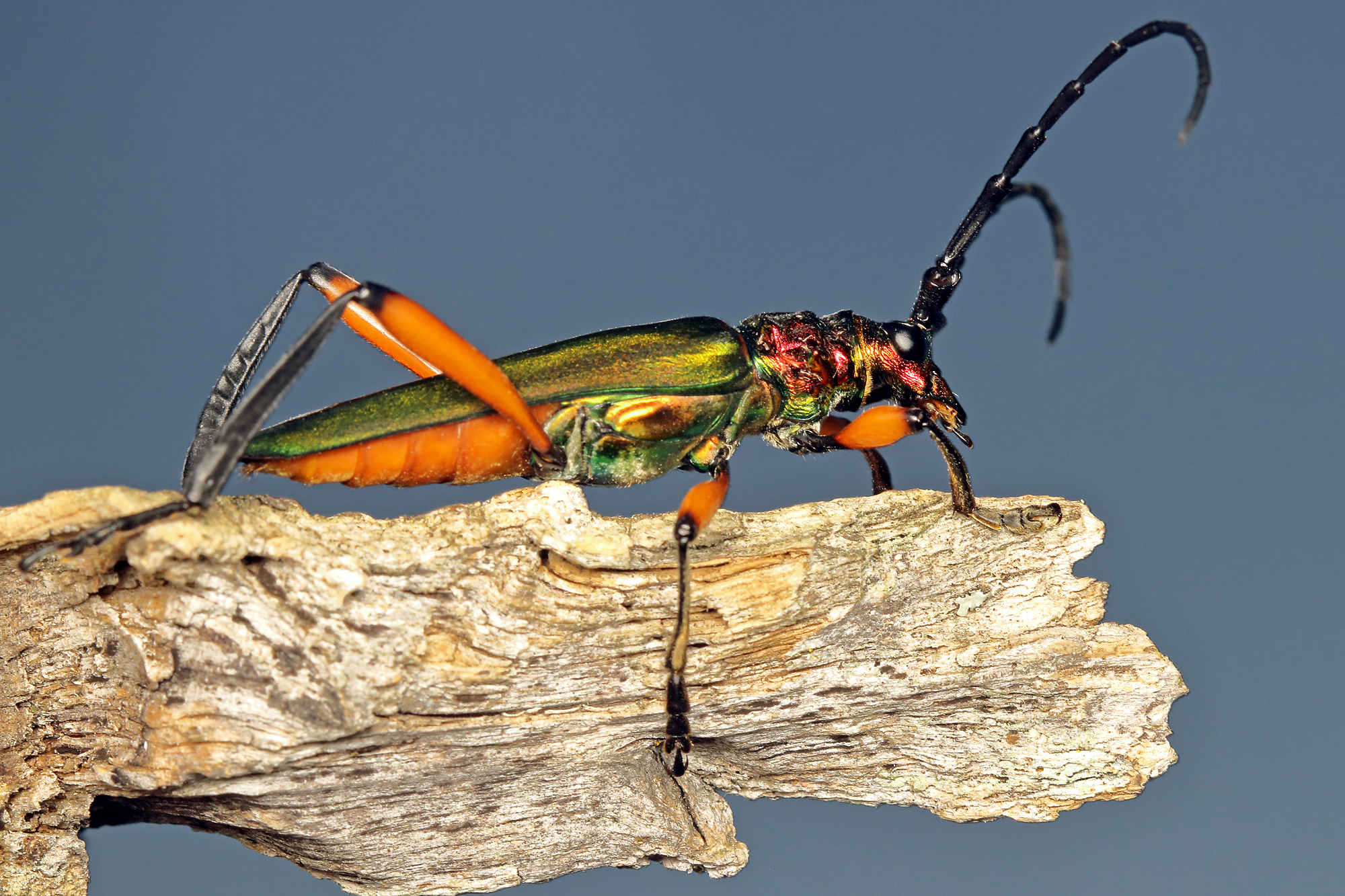In my previous post, I talked about a day trip to a sand scrub remnant in the Lake Wales Ridge of central Florida to find and photograph the endemic Highlands tiger beetle (Cicindelidia highlandensis). Ironically, the dry sand scrub/pine woodland habitats along this ridge are dotted with small lakes and ponds, allowing a rich aquatic flora and fauna to co-exist alongside the xeric specialists. Field mate Chris Brown and I had found and just finished photographing the tiger beetles when we encountered this rather largish lake—bright, white sand surrounding crisp, clear water reflecting white, puffy clouds in a deep, blue sky. ‘Twas a spectacular sight, indeed!

Sand scrub remnant, Lake Wales Ridge, central Florida
As we stood looking at the scenery, I noticed something black on the stem of one of the sedges growing along the water’s edge. Something big and black! As I moved closer I could tell quickly that it was a large horse fly, but it was not simply perched and resting on the sedge—there was something else going on. Moving closer, ever so cautiously so as not to disturb the fly, I eventually realized that it was a female in the act of oviposition. How cool—I’d never witnessed this before with any species of horse fly, so to see it with such a large species was a real treat. I recognized it instantly as Tabanus atratus—commonly called the black horse fly and recognizable as such by its large size, all-black coloration, and distinctively hooked antennae (see 3rd photo below).

A Tabanus atratus female oviposits on a stem overhanging the water.
Before we get to the eggs, let’s dispel some misinformation that seems to persist regarding the size of this species (as it does with almost any large insect). Black horse flies are undeniably large, and in fact they are one of the largest horse flies in North America. The more credible sources (e.g., Pechuman et al. 1983, Long 2001) cite body length as ranging from 20–25 mm (up to a full inch in length). Incredibly, the species does not take the honors as North America’s largest horse fly, which goes instead to Tabanus americanus and it’s upper limit of 30 mm (in fact, T. americanus may be the world’s largest horse fly)! There are, however, on-line sources and a few popular field guides (as cited in BugGuide) that state a maximum length of 28 mm for T. atratus. How credible this figure is I cannot say, but I guarantee that the size indications of 30, 40, and even a whopping 50 mm in length found routinely among photos of this species on BugGuide were not derived from careful measurement and almost certainly instead reflect the astonished reactions that such an abnormally large insect can generate! In fact, there are precious few insects in North America that reach lengths as grand as 50 mm (i.e., two full inches)!

Lateral view of oviposition.
We approached carefully, again so as not to disturb the female in the middle of her act, and we watched and photographed as she laid the individual eggs one by one, using the tip of her abdomen to carefully arrange them neatly against each other in stacked layers. From a photographic perspective, balancing flash exposure of the all-black adult with the bright-white egg mass presented a real challenge. Added to that was an additional exposure challenge (my desire for a blue-sky background), making it a truly difficult-to-photograph subject. Long (2001) states that T. atratus egg masses can contain anywhere from one hundred to a thousand eggs each, always near water’s edge or somewhere quite close to water. Females are capable of laying three or four of these egg masses, which apparently gradually turn dark as the eggs develop and approach hatch.

Freshly laid Tabanus atratus egg mass.
Despite this being the first time I’ve ever witnessed oviposition by this species, it seems to be encountered regularly. There are several photos of ovipositing females among the many photos of this species that have been posted to BugGuide. Moreover, descriptions of the egg mass of T. atatus appeared very early in the literature, first by Hart (1895) and then in photographs by Schwardt (1936). The latter author also states “T. atatus deposits its eggs in masses which are so constant in structural plan as to make specific determination of the egg mass readily possible” (as quoted in Bailey 1948). Thus, even if this female had already finished and left her egg mass, it still could have been identified to species.
REFERENCES:
Bailey, N. S. 1948. Notes on Tabanus atratus subsp. nantuckensis Hine (Diptera). Psyche 55(3):131–138 [pdf].
Hart, C. A. 1895. On the entomology of the Illinois River and adjacent water. Illinois State Laboratory of Natural History Bulletin 4:149–273 [eBook].
Jones, C. M. & D. W. Anthony. 1964. The Tabanidae (Diptera) of Florida. U.S. Department of Agriculture, Agricultural Research Service, Technical Bulletin No. 1295, 85 pp. [pdf].
Long, W. 2001. Tabanus atratus (on-line), Animal Diversity Web. Accessed 20 March 2019 at https://animaldiversity.org/accounts/Tabanus_atratus/
Pechuman, L. L., D. W. Webb & H. J. Teskey. 1983. The Diptera, or true flies, of Illinois 1. Tabanidae. Illinois Natural History Survey Bulletin 33(1):1–121 [pdf].
Schwardt, H. I. 1936. Horseflies of Arkansas. Arkansas Agricultural Experiment Station Bulletin 332:14–15, 27–32.
© Ted C. MacRae 2019




